|
This species has been introduced into California. It is not a native species.
|
 |
| Adult, Huntington Beach, Orange County |
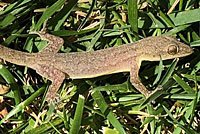 |
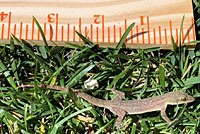 |
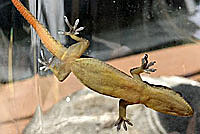 |
| Adult, Huntington Beach, Orange County |
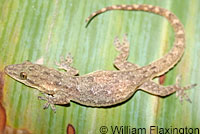 |
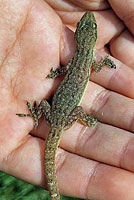 |
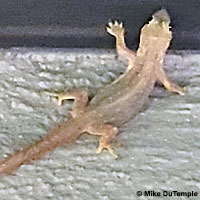 |
Adult, Orange County
© William Flaxington |
Adult, Huntington Beach, Orange County |
Adult, Vista, San Diego County
© Mike DuTemple |
| |
Pictures of Indo-Pacific Geckos from Outside California |
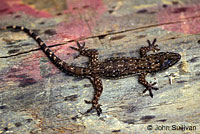 |
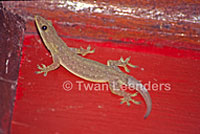 |
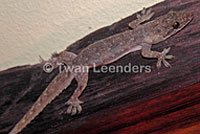 |
Adult in dark phase,
Miami-Dade County, Florida
© John Sullivan |
Adult, Dominical, Puntarenas Province, Costa Rica © Twan Leenders |
Adult, Manuel Antonio, Puntarenas Province, Costa Rica © Twan Leenders |
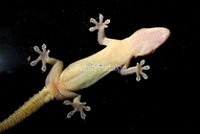 |
 |
|
Adult, Santo Tomas Heredia,
Costa Rica © Fabio Hidalgo |
Adult, Quepos, Costa Rica
© Fabio Hidalgo |
|
| |
|
|
| Description |
| |
| Size |
Adults are 4 - 5.5 inches in length (10 - 14 cm) including the tail. Head-body maximum length is 2.5 inches (6.4 cm).
|
| Appearance |
A small gecko with sticky toe pads and large eyes with vertical pupils and no eyelids.
The snout is relatively long and thin, longer than the distance between the eye and the ear-opening (similar to that of a fox, which explains the name Fox Gecko.)
A single saw-tooth row of enlarged, spine-like scales along the lateral edge of the tail.
The skin is smooth, but not shiny.
|
| Color and Pattern |
Generally brown or gray in color, sometimes marbled with darker brown.
Darker in the daytime, becoming pale and almost translucent at night.
Small whitish dorsal spots of varying sizes and shapes.
Sometimes there are faint cross-bands on the tail.
The belly is often lemon-yellow and the underside of the tail is sometimes pale red. |
| Young |
Hatchlings are 7/8 - 1 inch in length with a distinct pattern and dark cross-bands on the tail.
|
| Comparison with the similar Mediterranean Gecko - Hemidactylus turcicus |
The best way to differentiate these two species is the skin: the Indo-Pacific Gecko has smooth skin, while the Mediterranean Gecko has conspicuous large bumpy tubercles on the skin. The Indo-Pacific Gecko also has a yellow belly while that of the Mediterranean gecko is pale but not yellow.
|
| Comparison with the similar Common House Gecko - hemidactylus frenatus |
The Common House Gecko has been found in the wild in California, but it is apparently not yet established in the state.
According to geckoweb:
"The Indo-Pacific Gecko may have small tubercles restricted to its dorsum or dorso-lateral rows, and the Common House Gecko has only small or no tubercles, whereas the ... Mediterranean Gecko have enlarged tubercles across the back. ... In the Indo-Pacific Gecko, spines are only found along the sawtooth edges of the tail, however in the Common House Gecko, rows of enlarged spines encircle the tail."
|
| Life History and Behaviors |
Activity is almost completely nocturnal.
Hides in cracks and crevices and underneath ground surface objects during daylight.
Sticky pads on the toes allow this gecko to climb vertical surfaces. They are often seen on walls of building around outside lights where they wait to jump and catch with their open mouth insects that are attracted to the light.
|
| Diet |
| Eats a variety of invertebrates including insects and spiders. |
| Reproduction and Young |
This species is all female.
Reproduction is by parthenogenesis - the development of unfertilized eggs.
One individual is capable of establishing a new population.
Eggs are laid in pairs in dark places such as crevices, moist soil, and in crevices.
|
| Habitat |
In California, this species is associated with human development, mostly found on buildings with outdoor lights.
|
| Range |
Natural Range
This gecko is native to South and Southeast Asia, the East Indies, and many South Sea islands, including Northeast India, Bangladesh, Nepal, Myanmar, Thailand, the Malaysian Peninsula, Southern China, Taiwan, the Philippine Islands, Indonesia, New Guinea, new Caledonia, Polynesia, Fiji, Western Samoa, Vanuatu, the Cook Islands, and Tonga.
|
Introduced Populations
Established in Florida, Georgia, Hawaii, Texas and California, and in the Bahamas and Costa Rica.
California
Documentation of this species in California was first published in
December 2015. (Gregory B. Pauly and Glen S. Yoshida. Herpetological Review 46(4), 2015.) The authors do not mention the source of the introduction, but they do say that the evidence suggests that the introduction is recent, having been first observed in 2015.
So far (as of 4/20) my searches find that this gecko has been seen only in Los Angeles, Orange, and San Diego Counties.
* A population was found in Torrance, Los Angeles County, where it has been observed active during every month of the year since 2011. This population is apparently confined to one house lot.
* A population was found in Lake Forest, Orange County where adults and juveniles have been observed since 2009. This population was found in an area spanning eight house lots.
* A population was found
in the city of Orange in Orange County in July 2014 by Anthony C. Huntle.
* A population of H. garnotii has been documented in a third county at a residence in University City in San Diego County. Residents reported seeing them at the location since 2015-2016. (Herpetological Review 49(4) December, 2018)
* Pictures of a gecko found in Vista, San Diego County, that I presume to be H. garnotii, were sent to me in 9/19.
* Pictures of this gecko were sent to me from Huntington Beach in 4/20
* iNaturalist records show them from Anaheim, Irvine, and Santa Ana. (Accessed 4/20)
I have also received reports with pictures of alien geckos that might be this species from Los Angeles, Anaheim, and Palm Springs but the species has never been confirmed.
Los Angeles County
Between Rancho Palos Verdes and San Pedro
West of San Pedro
Torrance
Orange County
Anaheim
Huntington Beach
Irvine
Lake Forest
Orange
Santa Ana
San Diego County
University City
Vista
|
 |
Estimated world range of Hemidactylus garnotii, including areas where it has been introduced.
|
| Taxonomic Notes |
See The Reptile Database for synonyms.
|
| Conservation Issues (Conservation Status) |
It is not yet known what effect introduced populations of this lizard might have on native wildlife.
This gecko is a very successful invader. The ability of a single lizard to start a new population and the species easy adaptability means it could become widespread in California. However since it prefers warm climates, it may be limited to the southern part of the state. It is not known what impact it might have on native wildlife.
Introduced into Hawaii, the species has apparently been pushed out of urban areas by another alien gecko, the House Gecko, but continues to be found in most other habitats. |
|
|
Taxonomy |
| Family |
Gekkonidae |
Geckos |
Gray, 1825 |
| Genus |
Hemidactylus |
House Geckos |
Gray, 1825 |
| Species |
garnotii |
Indo-Pacific Gecko |
Dumeril and Bibron, 1836
|
|
Original Description |
Dumeril and Bibron, 1836
|
|
Meaning of the Scientific Name
|
Hemidactylus - Hemidactylus - Greek - hemi = half + Greek - daktylion = fusion of digits
Refers to the split lamella of the fingers and toes in this genus, i.e. the “half” (hemi) lamella under the fingers (Greek 'dactylos')
garnotii - in honor of French naturalist Prosper Garnot
|
|
Alternate Names
|
Fox Gecko
Garnot's House Gecko
|
|
Related or Similar California Herps
|
Peninsular Leaf-toed Gecko - Phyllodactylus nocticolus
Non-native geckos in California
Rough-tailed Gecko - Cyrtopodion scabrum
Common House Gecko - Hemidactylus frenatus
Indo-Pacific Gecko - Hemidactylus garnotii
Tropical House Gecko - Hemidactylus mabouia
Flat-tailed House Gecko - Hemidactylus platyurus
Mediterranean Gecko - Hemidactylus turcicus
Yellow Fan-Fingered Gecko - Ptyodactylus hasselquistii
Ringed Wall Gecko - Tarentola annularis
Moorish Gecko - Tarentola mauritanica
|
|
More Information and References
|
Robert Powell, Roger Conant, and Joseph T. Collins. Peterson Field Guide to Reptiles and Amphibians of Eastern and Central North America. Fourth Edition. Houghton Mifflin Harcourt, 2016.
Bartlett, R. D. and Patricia Bartlett. A Field Guide to Florida Reptiles ad Amphibians. Gulf Publishing, 1999.
McKeown, Sean. A Field Guide to Reptiles and Amphibians in the Hawaiian Islands. Diamond Head Publishing, Inc. 1996.
Wikipedia
Savannah River Ecology Laboratory
The Reptile Database
|
|
|
The following conservation status listings for this animal are taken from the July 2025 State of California Special Animals List and the July 2025 Federally Listed Endangered and Threatened Animals of California list (unless indicated otherwise below.) Both lists are produced by multiple agencies every year, and sometimes more than once per year, so the conservation status listing information found below might not be from the most recent lists, but they don't change a great deal from year to year.. To make sure you are seeing the most recent listings, go to this California Department of Fish and Wildlife web page where you can search for and download both lists:
https://www.wildlife.ca.gov/Data/CNDDB/Plants-and-Animals.
A detailed explanation of the meaning of the status listing symbols can be found at the beginning of the two lists. For quick reference, I have included them on my Special Status Information page.
If no status is listed here, the animal is not included on either list. This most likely indicates that there are no serious conservation concerns for the animal. To find out more about an animal's status you can also go to the NatureServe and IUCN websites to check their rankings.
Check the current California Department of Fish and Wildlife sport fishing regulations to find out if this animal can be legally pursued and handled or collected with possession of a current fishing license. You can also look at the summary of the sport fishing regulations as they apply only to reptiles and amphibians that has been made for this website.
This is a new species to California, so there are no status listings yet for the state.
|
| Organization |
Status Listing |
Notes |
| NatureServe Global Ranking |
Not Known |
|
| NatureServe State Ranking |
Not Known |
|
| U.S. Endangered Species Act (ESA) |
Not Known |
|
| California Endangered Species Act (CESA) |
Not Known |
|
| California Department of Fish and Wildlife |
Not Known |
|
| Bureau of Land Management |
Not Known |
|
| USDA Forest Service |
Not Known |
|
| IUCN |
Not Known |
|
|
|
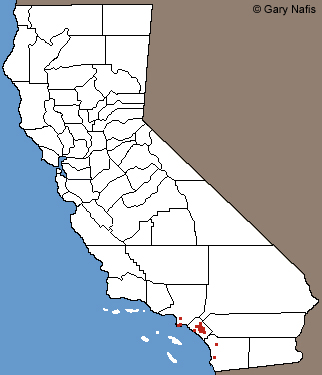 Red: Areas where this non-native species
Red: Areas where this non-native species 













